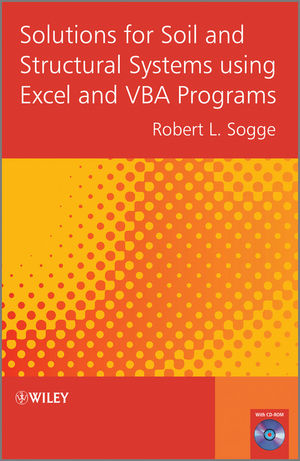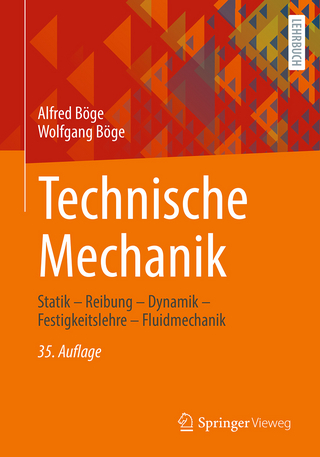
Solutions for Soil and Structural Systems using Excel and VBA Programs
John Wiley & Sons Inc (Verlag)
978-1-119-95155-1 (ISBN)
- Titel z.Zt. nicht lieferbar
- Versandkostenfrei
- Auch auf Rechnung
- Artikel merken
A practical guide to analyzing soil and structural systems using Excel spreadsheets and VBA macro programs (in open-source code) that are provided on the accompanying CD.
This book gives readers the tools to understand the methods such as finite element analysis used to analyze common problems in structural engineering, foundation engineering and soil-structure interaction. The book has value just based on its instructions in Excel spreadsheets and the Visual Basic for Applications (VBA) macro programming language alone. By providing an expert system and guidance to the reader in its use through examples, the author shows the methods and simple modelling techniques that demystify soil-structure applications by presenting the essentials in a clear and concise way.
The book also addresses some of the disappointments in geo-engineering by providing tools to calculate deformations, implement soil-structure interaction procedures, provide simple computer solutions, while incorporating proper soil and rock properties in the analyses.
Can be used by students or practicing professional engineers as a hands-on self-study guide as prewritten complete Excel spreadsheets and VBA programs are applied to many different Civil Engineering example problems
VBA code techniques and its use and programming are explained but a working knowledge is not required to use the spreadsheet and programs provided
Computations are performed using VBA macro programs getting input data from worksheet cells (whereby the spreadsheet functions as a pre-processor) or from input data files
Robert L. Sogge has a background which includes training, teaching, research and practical consulting in the area of soil-structure interaction. He achieved his PhD in Civil Engineering at the University of Arizona, USA, and practices in that state and California. He has developed many of these computer programs in the pursuit of his work as a consultant.
Robert L. Sogge has a background which includes training, teaching, research and practical consulting in the area of soil-structure interaction. He achieved his PhD in Civil Engineering at the University of Arizona, USA, and practices in that state and California. He has developed many of these computer programs in the pursuit of his work as a consultant.
About the Author xxi
Preface xxiii
Acknowledgments xxv
PART ONE COMPUTER SOFTWARE 1
1 Microsoft Excel Spreadsheet 3
1.1 History of Spreadsheet Development 3
1.2 Excel 2010 4
1.3 Transmitting Cell Values Not Formulas 5
1.4 Accuracy 5
1.5 Saving 6
1.6 Implementation of Excel Features 6
2 Microsoft VBA Programming Language 13
2.1 History of the BASIC Computer Language 13
2.2 Justification for Using Excel with VBA Macros 15
2.3 Difference between aWorkbook and a VBA Macro 16
2.4 VBA Macro Nomenclature 16
2.5 Generating a Procedure 17
2.6 Security Level Required to Open VBA Macros 19
2.7 VBA Code Statements that Differ from Previous BASIC Versions 19
2.8 Implementation of VBA Macro Programming 20
2.9 Inputting Data to a VBA Procedure 26
2.10 Output Data from a VBA Procedure 30
2.11 Running a Macro 32
2.12 Code Debugging 33
2.13 Charting in a Worksheet 34
2.14 Line Plots in a Worksheet 34
2.15 Macro Sub Program Showing Output toWorksheet 35
2.16 Computer Hardware/Software Requirements 36
PART TWO STRUCTURES 41
3 Finite Element Method – The Theory 43
3.1 Theory 43
3.2 Developing the Element Stiffness Matrix 44
3.3 Creating the Global Stiffness Matrix by Assembling Element Stiffnesses 47
3.4 Solving Simultaneous Equations for Displacements 47
3.5 Element Displacements and Forces 48
3.6 Flowchart of Steps 49
4 Finite Element Analysis VBA Program PFrame 51
4.1 Program PFrame – Finite Element Analysis (FEA) of Beam–Bar Structural Systems 51
4.2 Creating an Input Data Worksheet 52
4.3 Input Data 52
4.4 Joint Numbering and Dimensions 56
4.5 Load Application 58
4.6 Imposed Joint Displacements 59
4.7 Unstable or Improperly Supported Configurations 60
4.8 Running Program PFrame 60
4.9 Output Data 62
4.10 Alternate Solution Approach to Macro Program PFrame 63
4.11 Significant Aspects of Excel Worksheet & VBA Macro Program Construction 63
5 Beams 65
5.1 Beam Member Types 65
5.2 Bar Members as Pinned-End Beams 65
5.3 Moment of Inertia Conversion for Different Member Axis Orientation 67
5.4 Load Application 69
6 Frames 71
6.1 Analysis of Frames 71
6.2 Rigid Joints 71
6.3 Joint Numbering 71
6.4 Pinned-End Beam 73
6.5 Supports 74
6.6 Varying EI of Members Comprising a Frame 75
6.7 Stability – The P–Delta Effect 76
6.8 Load Case Combinations of Load Groups 76
6.9 Interior Member Forces 77
6.10 Examples 77
7 Trusses 81
7.1 Theory for Bar Members 81
7.2 Analysis of Bar Assemblage 81
7.3 Load Application 82
7.4 Initial Member Length Changes 82
7.5 Support Displacements 82
8 Reinforced Concrete 83
8.1 Concrete and Reinforcing Steel Properties 83
8.2 Design Capacity and Reinforcing Requirements 84
8.3 Strength Properties for a Soil–Structure Interaction Analyses 89
8.4 Cracked-Section Concrete Properties 90
8.5 Excel Workbooks 91
8.6 Notation 92
PART THREE SOILS 95
9 Soil Classification 97
9.1 Field Geotechnical Processes 97
9.2 Soil Description 100
9.3 Field and Laboratory Tests for Soil Identification 103
9.4 Soil Classification Systems 106
9.5 Excel Workbooks and VBA Programs 108
9.6 Soil Mechanics Symbol Nomenclature 109
10 Soil Strength Properties 115
10.1 Discrete and Elastic Finite Element Models 115
10.2 General Elasticity Equations Relating Stress and Strain 115
10.3 Modulus of Elasticity and Poisson’s Ratio 118
10.4 Coefficient of Subgrade Reaction 135
10.5 Mathematical Descriptions of Curves Using Program Curve Fit 138
11 Stresses in an Elastic Half-Space 141
11.1 Closed-Form Elasticity Solutions 141
11.2 Lateral Stresses against a Wall Restrained from Movement due to Point, Line, and Strip Loading 141
11.3 Boussinesq Equation 141
11.4 Westergaard Equation 142
11.5 Mindlin Equation 142
11.6 Chart Solutions 142
11.7 Excel Workbook – Lat&VertStress 143
11.8 VBA Program HSpace 143
11.9 Significant Programming Aspects 144
11.10 VBA Program HSpace – Program Documentation 144
12 Lateral Soil Pressures and Retaining Walls 149
12.1 Lateral Earth Pressure – Sloped Backfill Acting on Inclined Retaining Wall 149
12.2 Slope Stability 150
12.3 Stability of a Vertical Cut 150
12.4 Retaining Wall Movements 151
12.5 Retaining Walls – Factor of Safety 151
13 Shallow and Deep Foundation Vertical Bearing Capacity 153
13.1 Shallow Foundations 153
13.2 Vertical Bearing Stress Capacity 153
13.3 Soil Pressure Distribution 154
13.4 Settlement-Based Bearing Capacity 155
13.5 Excel Workbooks 156
13.6 Deep Foundations 156
13.7 Capacities Based on Displacement Limits 157
13.8 Capacities Based on Stress Limits 158
13.9 Limitations on Capacities 160
13.10 Load Testing 161
13.11 Pier Settlement 161
13.12 Excel Workbook 161
13.13 Combined Foundations – Shallow and Deep 161
14 Slope Stability 165
14.1 Workbook Program Slope – Slope Stability by Bishop’s Modified Method of Slices 165
14.2 Workbook Program STABR – Slope Stability by Bishop’s Modified Method of Slices 166
14.3 Workbook Program Slope8R – Slope Stability by Spencer’s Procedure for Non-circular Slip Surfaces 167
15 Seepage Flow through Porous Media 169
15.1 Program Flownet for Analysis of Seepage Flow through Porous Media 169
15.2 Program Input – from Data file 170
15.3 Program Output – to Data File 171
15.4 Input Data Description 172
15.5 Output Data Description 172
15.6 Example 172
15.7 Significant Aspects of Excel Workbook and VBA Macro Program Construction 174
PART FOUR SOIL–STRUCTURE INTERACTION 177
16 Beam-on-Elastic Foundation 179
16.1 Theory–Classical Differential Equation Solution 179
16.2 Beam–Bar Finite Element Model 180
16.3 Soil Strength – Coefficient of Vertical Subgrade Reaction 182
16.4 Structural Stiffness 183
16.5 Soil–Structure Interaction 183
16.6 Unbalanced Fixed-End Moment from Triangular Load Distribution 184
16.7 Pressure Distribution 184
16.8 Solution Exclusively in Excel Worksheet without VBA 185
16.9 Examples 187
17 Footings andMat Foundations 191
17.1 Mat Foundations 191
17.2 Slab Section Stiffness and Moment Capacity 192
17.3 Soil–Structure Interaction 192
17.4 Practical Considerations Regarding Slab Reinforcement 193
17.5 Case Study – House Slab Foundations in Tucson, Arizona 197
17.6 Example 17.1 House Slab 197
18 Laterally Loaded Piles 201
18.1 Theory – Classical Differential Equation Solution 201
18.2 Conventional Analysis 202
18.3 Beam–Bar Finite Element Solution 202
18.4 Structural Stiffness 207
18.5 Soil Strength 209
18.6 Soil–Structure Interaction 213
18.7 Soil Pressures on Each Side of Pier 215
18.8 Limitations of a Beam–Bar Analysis 219
18.9 Design Procedure 219
18.10 Solution Exclusively in Excel Worksheet without VBA 221
18.11 Point of Fixity 222
18.12 Pile Groups 222
18.13 Conclusions 222
18.14 Significant Aspects of Excel Worksheet and VBA Macro 223
18.15 Examples 223
19 Cantilevered and Anchored Sheet Piles 229
19.1 Cantilevered Sheet Piles 229
19.2 Beam–Bar Finite Element Model for Cantilevered Piles 229
19.3 Anchored Sheet Piles 229
19.4 Beam–Bar Finite Element Model for Anchored Sheet Piles 230
19.5 Soil Strength Representation 230
19.6 Examples 231
20 Buried Arch Culverts (Tunnels) 233
20.1 Theory: Classical Elasticity Formulation – Burns and Richard Solution 233
20.2 Soil–Structure Interaction 234
20.3 Beam–Bar Finite Element Frame Model 235
20.4 Vertical Loads 237
20.5 Distributing and Attenuating Vertical Live Loads 238
20.6 Horizontal Ko Pressure Load 240
20.7 Load Application 240
20.8 General Elasticity FEA Programs 241
20.9 SSI 242
20.10 Cracked-Section Considerations 243
20.11 Examples 244
21 The Arch Form 247
21.1 History of Arches and Vaults 247
21.2 Arch-Shaped Configurations 247
21.3 Force Determination for Various Shaped Arches 249
21.4 Arch Engineering Considerations 250
21.5 Structural and Hydraulic Efficiency 252
21.6 Soil–Structure Interaction 253
21.7 Flexible versus Rigid Structures 254
21.8 Failure Patterns and Deflections 255
21.9 Load Tests 256
21.10 Design Comments 256
21.11 Buckling of Arches 260
21.12 Seismic Design Considerations 261
PART FIVE ENGINEERING APPLICATIONS 263
22 Domes 265
22.1 Geometry 265
22.2 Membrane Stresses 265
22.3 Stress Computations Using Worksheet Dome 266
23 Critical Path Method 269
23.1 Project Scheduling 269
23.2 VBA Versions 270
24 Financial Analysis 271
24.1 Equations Governing Financial Operations 271
24.2 Excel Worksheets for Financial Calculator and Formulas 272
24.3 Significant Aspects of Excel Worksheet and Macro Functions 272
25 Conversion of Units of Measurement 275
25.1 Unit Systems 275
25.2 Defined Units 276
25.3 Labeling Conventions 276
25.4 Workbook UnitCnvrsn 277
25.5 Excel Conversions 278
25.6 Example 278
Related Workbook on DVD 278
Index 279
| Erscheint lt. Verlag | 4.10.2012 |
|---|---|
| Verlagsort | New York |
| Sprache | englisch |
| Maße | 177 x 252 mm |
| Gewicht | 649 g |
| Themenwelt | Technik ► Bauwesen |
| Technik ► Maschinenbau | |
| ISBN-10 | 1-119-95155-0 / 1119951550 |
| ISBN-13 | 978-1-119-95155-1 / 9781119951551 |
| Zustand | Neuware |
| Informationen gemäß Produktsicherheitsverordnung (GPSR) | |
| Haben Sie eine Frage zum Produkt? |
aus dem Bereich


